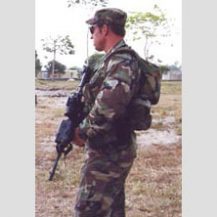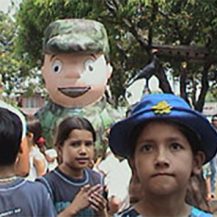Washington’s New Weapon in the War on Drugs
Washington’s drug warriors claim Fusarium oxysporum will eradicate illicit crops in a “tested, environmentally safe” manner.
This text originally published: 30 July 2000

Couched in the final version of the $1.3 billion U.S. aid package to Colombia (signed by President Clinton on July 13) is a passing reference to the deployment of “tested, environmentally safe mycoherbicides” as part of a strategy “to eliminate Colombia’s total coca and opium poppy production by 2005.” Despite considerable U.S. funding and technical support for Colombian aerial fumigation campaigns over the past several years (see, U.S. Mercenaries in Colombia), production of coca- and poppy-derived narcotics has more than doubled since 1995. This policy failure has frustrated drug authorities that once trusted in the efficacy of chemical herbicides like glyphosate (Monsanto’s Roundup) to wipe out “drugs at their source” and prodded them to seek more effective weapons against illicit crops.
The drug warriors are now hanging many of their hopes on mycoherbicides (fungi that attack other plants), promoting them as a tested, natural, and safe way to eradicate specifically targeted crops. Unfortunately, available evidence suggests an entirely different outcome from the one Washington is propagating.
The mycoherbicide currently being touted by the drug warriors is Fusarium oxysporum, which first caught the attention of U.S. authorities in the 1970s when a Coca Cola-owned coca plantation in Hawaii was decimated by a mysterious plague. (The company was permitted to grow coca under government supervision for use as an extract in its beverages.) Tests by the U.S. Department of Agriculture’s Agricultural Research Service (ARS) isolated a strain of Fusarium oxysporum (dubbed EN-4) as the origin of the blight, which caused the coca plants and subsequent plantings of the crop to wilt and die. Impressed by the possibilities of Fusarium as a mycoherbicide, the U.S. government embarked on extensive—and sometimes classified—research of the fungus, spending some $14 million over the next two decades.
By the early 1990s, there were numerous allegations that the United States had conducted its first “field test” of Fusarium over the coca fields of Peru. Peasants in the Upper Huallaga Valley reported seeing helicopters and airplanes spraying clouds over their crops (some of which were coca), and that shortly thereafter their plants had wilted and perished and their animals had grown sick. The UN Development Program office in Lima, whose responsibilities included overseeing crop substitution initiatives, registered a number of complaints that the helicopters had departed from the Santa Lucia antidrug base, a facility built by the U.S. Drug Enforcement Agency (DEA). Precisely what triggered the fungal outbreak in the Huallaga Valley is still unknown, but it is certain the blight resulted from none other than Fusarium oxysporum.
The U.S. government denied involvement in the Fusarium outbreak in Peru and deflected criticism by asserting that it was a natural phenomenon. Then-U.S. drug czar Bob Martinez stated that, “The United States has not been, is not, nor will it be involved in any kind of use of chemicals.” Strictly speaking, however, Martinez’s statement did not deny U.S. culpability for the fungal outbreak, which was, after all, a biological and not a chemical occurrence. When pressured, he acknowledged “a lot of research” in the United States but would not comment further.
Considering the heightened drug war context of the early 1990s, the peasants’ consistent testimonials about aerial fumigation, the initial concentration of the outbreak around a DEA facility, and Washington’s years of research into the very mycoherbicide that broke out in the spraying’s immediate aftermath, there is much room to doubt the U.S. government’s conviction. And the fact remains that the outbreak yielded a clear example of Fusarium’s destructive power against coca in a non-laboratory setting—precisely the type of real-world “results” sought by U.S. researchers since the Hawaii incident.
The Peruvian outbreak also brought to light alarming facts that U.S. government researchers had previously noted and suppressed: that specific strains of Fusarium—including EN-4—attacked not only target crops, but a slew of other plants as well. The U.S. embassy in Lima monitored the situation in the Huallaga Valley carefully, and an ARS-hired Peruvian specialist concluded that, aside from coca, the Fusarium was killing tomatoes, achiote and papaya. Peasants reported that tangerines, palms, and other broadleafed plants had also succumbed to the fungus.
An important corollary effect of the blight was the widespread fear among peasants of planting any crop in the tainted soil—a valid concern highlighting an inconsistency in the international community’s current policy of simultaneously advocating crop spraying and crop substitution.
If Peru was the closest thing to a field test Fusarium advocates had until recently, in 1999 Florida almost provided them with a “laboratory” much closer to home. That year, a controversial plan to use a strain of the fungus against marijuana crops in Florida was shelved after a concerted campaign by environmentalists, some state officials, and citizens. Floridians’ objections to the proposed use of the mycoherbicide included the testimony of the state’s Secretary of Environmental Protection, Dr. David Struhs, who warned of Fusarium’s staying power in soil (some sources claim it can remain present for up to 40 years) and highlighted the fungus’ unpredictable capacity to mutate and affect plant species far removed from the designated targets. Struhs also cautioned that, “It is difficult, if not impossible, to control the spread of Fusarium species.”
Florida’s rejection of Fusarium put Washington’s drug authorities—and the Ag/Bio Con Company that sees big profits in marketing the strains it owns—on the offensive. As a result of their lobbying, the language of the Senate’s version of the Colombia aid package, which held that any herbicide to be employed in Colombia must first be tested and approved by both the U.S. Surgeon General and the Environmental Protection Agency, was softened in the final version to a vague reference to using “tested, environmentally safe mycoherbicides.”
In June, U.S. drug czar Barry McCaffrey’s Office of National Drug Control Policy (ONDCP) issued a report claiming the EN-4 strain of Fusarium does not mutate, and that “over 100 plant species have been tested for susceptibility to this pathogen. None have been adversely affected.” The report dismissed concerns that humans exposed to Fusarium might be harmed, arguing that only “immune-suppressed cancer patients whose defense levels were very low” showed signs of sickness during testing. The ONDCP promised that any individuals in such conditions “would be hospitalized and quarantined and not exposed to coca spraying.”
To date, experts tell us there is little if any publicly available research from the ARS—which headed the at-times classified Fusarium project—to suggest that the EN-4 strain’s toxicity to humans and animals has been adequately studied. But there is evidence elsewhere that Fusarium can be quite harmful to humans and animals. After the Peru outbreak, peasants reported sicknesses in their animals, while Colombian researchers have shown the mortality rate for Fusarium-exposed humans is 76%. Given Fusarium oxysporum’s capacity to mutate, the ample evidence that other strains of the fungus contain cancer-causing toxins should not be downplayed.
The ONDCP report’s reassurances that “over 100 plant species” have been tested with no adverse effects belie the fact that there are over 200 plant species within the genus that the EN-4 strain of Fusarium oxysporum targets, all of which will be susceptible to attack. And while disclosed U.S. research has focused on examining Fusarium’s effects on isolated plant species in a controlled laboratory setting, the push now is for an open-air test of the fungus somewhere in the Amazon, the world’s most biologically diverse ecosystem.
Partly because of this, concern has arisen over the international legality of importing a strain of Fusarium oxysporum to a country where it does not naturally exist. If EN-4 does not exist in Colombia, under international law it cannot be brought there by outside agents that are not natural. Fearful of giving off the impression that it was set to unilaterally deploy what could be construed as an untested biological weapon (Fusariotoxin, which occurs in some strains of the fungus and can develop in mutated forms of EN-4, is listed as a biological warfare agent), the U.S. government turned over its ARS research and $23 million of State Department funds to the UN Drug Control Program (UNDCP).
The UNDCP was then supposed to act as the voice of the international community and get Colombia to accept EN-4 tests within its territory. This was in spite of the fact that the director of the UNDCP Colombia and Ecuador office, Klaus Nyholm, described the plan to pressure Colombia through the auspices of the UN as “an American interest.” Of critical importance here is the fact that Nyholm, when questioned by Sharon Stevenson and Jeremy Bigwood, the journalists who broke this story (see, Drug Control or Biowarfare?), went on record as saying there is no EN-4 in Colombia. Everyone Stevenson and Bigwood interviewed—guerrillas, government ministers, the Catholic Church, NGOs of all stripes, agronomists and even the aerial fumigation expert offered by the U.S. embassy in Bogotá—echoed Nyholm’s claim that there is no record of EN-4 in Colombia. Therefore, testing EN-4 in Colombia without Colombia’s consent would be illegal.
Yet the conditionality clause worked into the U.S. aid package left the Colombian government, already counting on the funds, in a difficult position: either accept testing of the Fusarium strain in Colombia despite serious safety and legal concerns, or reject the proposal and risk a delay or diminution of the U.S. aid package.
Another issue complicating (or perhaps simplifying) Colombia’s decision was the inclusion of wording in the proposal that would have denied Colombia any intellectual property rights to the results of the test while at the same time making it solely responsible for any unforseen problems arising from the experiments. Nyholm, perhaps after hearing it from his superiors, modified his position in early July, stating that, “Our experts tell us that it is worth trying,” and pointing out that the tests only need an area of “a couple of hundred square yards.”
Despite the fact that the ARS research handed over to the UNDCP shows that ants can carry and distribute the fungus, despite the fact that contaminated irrigation water and farm implements can spread the fungus, despite the fact that it is possible for the fungus’ spores to be spread by the wind, and despite the fact that in Peru the outbreak spread well beyond the areas where peasants reported seeing the fumigating aircraft, Nyholm said he felt the tests could be carried out safely and that they posed no threat to the surrounding ecosystem.
He also downplayed the Colombians’ apprehension over the heavy-handed tactics employed by his office and the U.S. government, stating, “I suppose this is because many people who are not specialists see this with biological warfare in mind, which is not the case.” But because Nyholm, as the UN official charged with overseeing the tests, has formally admitted that strain EN-4 of Fusarium oxysporum does not exist in Colombia, what else could the illegal introduction of this agent into Colombian territory against the wishes of the Colombian government be but an act of biological warfare?
Colombia’s response was unequivocal: “The government of Colombia, after consulting with national experts on the subject, does NOT (sic) accept the proposal put forth by the UN Drug Control Program to test the fungus of the variety Fusarium oxysporum, having considered that any agent foreign to the native ecosystems of our country could present serious risks to the environment and human health.” But Colombia’s Minister of Environment, Juan Mayr, added that Colombia was moving ahead with plans to investigate coca-fighting biological controls derived from native flora and fauna. Among other scenarios, this leaves open the possibility that EN-4 could be “discovered” at some point in the future, if need be.
It now appears that the U.S./UN alliance has sidestepped Colombia’s reluctance and the mounting legal scrutiny by shifting fronts. On July 17, El Nuevo Herald of Miami ran a front page story reporting that U.S. scientists had begun experimenting with Fusarium oxysporum in northeastern Ecuador. The paper said the experiments were occurring in the jungle some five kilometers north of Lago Agrio in the Sucumbíos province, which borders the Colombian province of Putumayo—a FARC guerrilla stronghold that Plan Colombia aims to attack.
The article cited Diego Pérez of the Center for Popular Research and Education (CINEP), a Colombian NGO, who reported witnessing ongoing Fusarium tests while he was in Sucumbíos collecting data in anticipation of the mass, counterinsurgency-induced exodus of Colombian peasants. Pérez also stated that a few weeks earlier, civic groups from Sucumbíos and Quito-based NGOs had appealed to Ecuadoran President Gustavo Noboa to stop the testing of Fusarium on Ecuadoran soil, but their request received little publicity until word of the experiments surfaced.
The next day, the Ecuadoran daily El Universo‘s front page article relayed the reports from the Nuevo Herald piece. Responding to the story, Ecuador’s Minister of Environment, Rodolfo Rendón, insisted that the Ecuadoran government had not authorized any such experiments, nor would it do so in the future. He said the government was shocked by the report, and that steps were being taken to verify the allegations. Another person expressing shock was the U.S. Ambassador in Quito, Gwen Clare, who said “We are surprised that a newspaper from the United States would publish an article with no basis, with information that is not true.” Clare asserted that the United States is not using nor will it use Fusarium oxysporum, either in Colombia or in Ecuador. President Noboa, when cornered by the Ecuadoran press, would not comment on the allegations. Gonzalo Guillén, the Nuevo Herald reporter, defended the integrity of his work and his source, CINEP’s Pérez.
While the allegations are so recent that conclusive proof one way or the other is not yet available, it is worth noting that Pérez was undoubtedly aware of the gravity of his statements and the scrutiny they would attract, as was the newspaper that printed them. CINEP itself has an impeccable reputation in the NGO community, and is renowned for its work documenting human rights abuses in Colombia. And it must be pointed out that Ambassador Clare’s rushed remarks contradict the explicitly stated intentions of her own government.
There is reason to believe that Pérez saw what he says he saw, and there are more than a few lingering reasons—including the beefed up U.S. military presence in northern Ecuador revolving around the Manta antidrug air base—not to doubt him. If, as Pérez maintains, there are U.S. scientists conducting tests on Fusarium oxysporum in the Ecuadoran jungle, it is likely that the much vaunted EN-4 strain is being tested. The location of the alleged experiments near the Colombian border suggests the possibility that the fungus could enter Colombia “naturally” at some point.
Recent history shows that years after the Peruvian outbreak, the fungus was still spreading, reaching areas well beyond the initially affected zone. Furthermore, it is crucial to recall that the fungus can be spread by insects, wind, water—even by contaminated objects. That last category may become especially important once U.S. funds for Plan Colombia start to have their effect. Already, more than 25,000 Colombian refugees have spilled into Ecuador’s border provinces, and those numbers are only expected to rise once the U.S.-sponsored counterinsurgency intensifies.
Local leaders in Ecuador’s Carchi province (which borders both Colombia and Sucumbíos) are seeking funds from Quito’s $25 million share of the U.S. aid package to help deal with the rising tide of displaced Colombians (see, Colombia’s Forgotten Refugees). Carchi’s leaders say they will tolerate the Colombians until Ecuadorans’ employment opportunities are compromised. Once their stay in Ecuador is cut short, returning refugees could unwittingly carry Fusarium oxysporum strains, currently not present in Colombia, into the country on their tools and belongings.
Washington’s drug warriors claim Fusarium oxysporum will eradicate illicit crops in a “tested, environmentally safe” manner. They are convinced the fungus will do what countless other methods have failed to accomplish: destroy Colombia’s coca fields and go a long way toward stopping drug flows from that country. Despite well-documented risks to a variety of untargeted plant species and to animals and humans, and with blatant disregard for the potentially catastrophic effects the fungus could have on the biodiversity of the Amazon, and in spite of the refusal of Colombia and Ecuador to play guinea pig to its essentially illegal experiments, the United States is sticking to its rhetoric and reasserting its intent to deploy Fusarium oxysporum in Colombia.
Meanwhile, Peru is still feeling the effects of the early 1990s Fusarium outbreak that numerous witnesses claim the United States engineered, and so far, U.S., UN and Ecuadoran authorities have failed to provide any satisfactory evidence to refute reports that Fusarium tests are underway in Ecuador. As for Colombia, the spore may already have been planted.
Notes
This article originally appeared in Colombia Journal, an online journal that was published by the Information Network of the Americas (INOTA).


